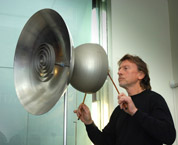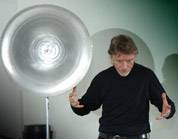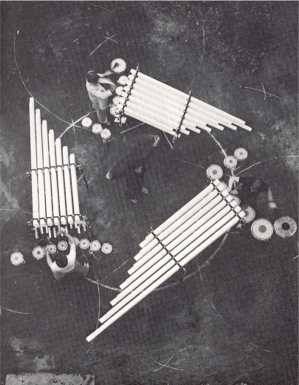A Labyrinth of Rhythm:
The sonic universe of Phil Dadson


Photos by Auckland Art Gallery
By David Cranstoun Welch
(December 2009)
There will always be something perplexing about the sight of a 60-something year old man beating ritualistically on a row of PVC pipes whilst blowing into a wooden device, with tubes snaking into a series of water glasses; issuing forth a gurgled and faintly obscene-sounding serenade. But this is what Phil Dadson has dedicated his life to- exploring alternative sound sources in an idiosyncratic and distinctly visual way. Dadson has been plowing this fertile soil for over 30 years, most famously with the avant-garde performance troupe From Scratch; a precursor to the highly successful but much-maligned 'Stomp' and Blue Man shows. As with those productions, listening to Dadson's recorded output provides you with only half the picture. To fully appreciate Dadson is to submit yourself to one of his theatrical and shamanistic multi-media live performances.
Dadson's shows, straddling a fine line between the serious and the absurd, but almost always managing to transport the viewer to a unique and rarefied place- have beguiled and bamboozled critics for decades. Gilbert Wong of the NZ Herald, in a review of Dadson's 'Pacific Plates' struggled to articulate From Scratch's singular appeal. "[Tonight] I have seen a man perform with water coolers strapped to his legs. As comical as this sounds, in the hands of... the From Scratch trio, the percussive beats boomed across the performing space with great effect."
A 1998 review of Dadson's 'Global Hockets,' by Andreas Obst of the Frankfurter Allgameine Zeitung, came closer to capturing the flavor of a From Scratch show by deploying frantic war correspondent-style reportage. Obst detailed with wide-eyed staccato a "stage... filled with puzzling constructions. Larger than a man, a labyrinth of rhythm; various percussion instruments, bells... joined together by a grid-like device. Plastic tubes in a long succession reach from playing height to the floor... cast metal handbells [are] grouped on a table. Bent metal rods grow out of an iron body like spines. The light is very low. [Through] loudspeaker boxes one hears noises such as at nighttime in a primeval jungle. Then: a powerful blow breaks the silence. It is followed by an almost hour long thunder storm of drums which ends almost as abruptly as it began. The four performers constitute a magnificent human machine of rhythm. Sounds and noise become music and a wondrous world of sounds develops. This is in great part due to the virtuosity of the musicians (performers) and partly due to the virtues and sound qualities of the materials with which they work. Materials from the building trade - wood, metal, PVC, and a sink of water."
Dadson's now defunct group, From Scratch and its ever shifting line-up, were based in Auckland, New Zealand from the mid-1970's until the early part of this decade. When the group first established its reputation, in 1974 it was as a foursome that included Dadson, Geoff Chapple, Bruce Baber and Barry Barque. In 1976, the group coalesced into the more familiar arrangement of Dadson, Chapple, Dadson-mainstay Wayne Laird and New Zealand music scene stalwart, Don McGlashen. Chapple dropped out in the mid 1980s, just as the group began to gain international recognition.
One of From Scratch's more popular works is 1985's 'Gung Ho 1 2 3 D', devised for PVC Pipe and chime bar instruments and arranged in an actual Chinese ideogram for the term Gung Ho, meaning 'work together.' In the same era, From Scratch produced 'Pacific 3,2,1 Zero Part 1' for tuned PVC pipes, chimes, drums, cymbals, voices, trom tubes, spun drones, rattle jackets and biscuit tins. An excerpt from this work was later included on Bart Hopkins' influential Gravikords, Whirlies & Pyrophones, still one of the best introductions to music designed for experimental instruments.
Dadson was born in the small port town of Napier, New Zealand. He graduated in sculpture at the Elam School of Fine Arts in Auckland. Dadson first began exploring alternative sound sources in the same way as many other art students of the 1960s: through the use of a portable tape recorder. "I started my first experiments at art school... slowing down [the tape], speeding it up, playing it backwards and so on..." Dadson said in a recent interview. The pivotal moment came when Dadson began attending weekly music classes at Morley College in London, while studying for his Fine Arts Degree, with revered avant-garde composer and former Stockhausen pupil, Cornelius Cardew.
Dadson became involved in Cardew's Scratch Orchestra, which comprised members from a variety of backgrounds- from the untrained amateur through to the seasoned professional. Anybody with the inclination could join the orchestra, and there was a heavy reliance on improvisation. In a radical maneuver, Cardew proposed that the responsibility of programming concerts should be assigned in reverse seniority, so that the first concert, on 1 November 1969 at Hampstead Town Hall, was designed by Christopher Hobbs, an eighteen-year-old student of Cardew's at the Royal Academy of Music.
Cardew's concepts had a profound influence on the young Dadson. "Cornelius was a mentor at the time, both in London and [in my home country] New Zealand" he relates. "[However] I can't say I had a particularly close personal relationship with [Cornelius]... although I did go camping in the South of France with him and his family. We also corresponded for some while when I was forming a group in New Zealand, right up until the time he rejected Scratch."
Cardew came to question the notion of 'art music'. This was would lead to the Orchestra being disbanded due to Cardew's feeling that it was as an 'elitist' organization. In 1979, Cadrew was a co-founder and member of the Central Committee of the Revolutionary Communist Party of Britain. His creative output from the demise of the Scratch Orchestra until his death reflected his political commitment. Cardew stated his attitude towards the avant-garde in 'Stockhausen Serves Imperialism': "I'm convinced that when a group of people get together and sing The Internationale this is a more complex, more subtle, stronger and more musical experience than the whole of the avant-garde put together." It is rumored that Cardew's death at age 45 in a 1981 auto accident was administered by Mi5 (aka English secret service) due to his increasingly radical sympathies.
One of the more immediately obvious elements of the Orchestra to impact Dadson was its "Fluxus-oriented influence, which lead to a more conceptual approach to music making." Fluxus was an international network of artists, composers and designers noted for blending different artistic media and disciplines in the 1960s. They were active in Neo-Dada, noise music and visual art as well as literature, urban planning, architecture, and design. Fluxus is often described as Intermedia, a term coined by Fluxus artist Dick Higgins. "Coming from an art school back ground, I related to this and to the 'intermedia' and 'happening'-styled experiments that the orchestra undertook. I took away from my experience a new confidence and an enthusiasm that bubbled over back in NZ. The spontaneity and improvisation that was at the core of so much of the Scratch Orchestra's activity... informs much of what I do now."
In 1972, Dadson established an off-shoot of the Cardew-lead collective, inventively dubbed 'The Scratch Orchestra NZ'. "I devised a Scratch Orchestra breakaway manifesto titled VOM (Variable Occasional Music), partly in opposition to the large free-for-alls that often took place under the umbrella of improvisation." The VOM manifesto, according to Dadson "proposed a 'probe and hatch' plan based on rhythm research and simple compositional ideas for which a new quartet was formed... essentially, the birth of 'From Scratch.' The kinds of structures I was devising around simple math formulas gave rise to polyrhythmic interplay and the sharing of parts. A style I was able, many years later to put a name to... hocketing." Hocketing has its roots in medieval music forms, such as the motet and madrigal and is also found in many traditional 'world' musics, like the Balinese Gamelan orchestra. Hocketing, in essence, is a device, consisting of phrases played by two or more musicians, broken up by pauses or 'rests,' in such a way that when one part is silent, another fills the gap. The word is similar to 'hiccup' and is derived from the French equivalent hoquet. As Dadson said in his essay 'Hocketing... notes towards a wider understanding,' "An essential element of hocketing is integration - the working together and interlocking of parts, a procedure that has its roots in the basic principles of masculine/feminine, active/passive, positive/negative, and sun/moon... primal universal forces of energy, creation and renewal."
"Around 1974," relates Dadson, when the Scratch Orchestra had evolved into From Scratch "Lucy Lippard, a New York art critic visited New Zealand, heard the group, and suggested I contact Steve Reich who was covering... similar ground. This was the first I'd heard of Reich ... but it led to my eventually meeting him in New York many years later when [From Scratch] performed 'Pacific 321' there in 1982. After putting a name to hocketing, I became interested of course, in the numerous traditions of the practice worldwide. The group had the pleasure of being invited to perform at the Bali Arts Festival in the early '90's and had probably our most appreciative audience of the hocketed interplay than any other we've performed to." The ritualistic qualities inherent in many of the traditional musics that employ hocketing found their way into Dadson's performance style, and have lead to his work being labeled in semi-religious terms. His discussing hocketing in reference to "the higher level of the 5th dimension" where "[hocketing] is the endless search for the 'twin soul', the meeting of the lower self and higher self, where the inner polarities of self are reconciled" has not done anything to alter this perception. However, Dadson's view is that "... any sense of ritual was a layer only... just one facet of the whole. The intention was to create a focus and reinforce a sense of the co-operative; laying out the ground plan ahead of performing... the circularity of performance style, the diagrammatic nature of the instrument layout etc. No specific shamanistic intent... if the viewer perceived it this way, which they sometimes did... and still do, then I guess it's more to do with a personal performing style and approach to improvisation. The immersing of oneself in the task."
Another hallmark of Dadson's own Scratch Orchestra NZ and the later From Scratch group was an unceasing exploration of texture through unusual and often self-devised instruments. "I began my first real event-making, performances and composition activities with [the formation of the New Zealand Scratch Orchestra] and these invariably required invented and/or improvised instruments." The first of these instruments was a "large zither made from a converted, stripped down piano frame. I could prepare and retune the strings in various ways, in the manner of Cage, Cowell and others." In the early 1950's, John Cage developed the 'prepared piano,' drawing from the innovations of composer Henry Cowell. The prepared piano is essentially a piano which has had its sound altered by the placement of objects between or on the strings or on the hammers or dampers. "The zither [I converted] was symbolic for me of a new direction; inspiration from the Scratch Orchestra and a veering away from my jazz piano background to something freer and more exploratory."
Unlike another former Scratch Orchestra member and legend in conceptual music, Brian Eno, Dadson chose to work with a strictly acoustic palette. "I have no attraction whatever, to playing synth music. But acoustic or electro-acoustic... yes! This is because of the rich and often unexpected timbral, harmonic and textural complexity that can be generated from materials such as woods, metals, stone, water, tubes and membranes. I find sound from acoustic sources more satisfying in all ways." Dadson's work serves as an interesting acoustic counterpoint to the electronic explorations of Eno; works like "Gung Ho," "Pacific Plates" and his recent "Soundtracks" covering similar ground to Eno's textural and rhythmic explorations in Ambient 3 & 4, Fourth World: Possible Musics and other pieces.

Photo from Art New Zealand
Another hallmark of Dadson's self-devised instruments is their often exaggerated scale and unusual appearance. "I'm attracted to physicality and to visual as well as sound presence. I like an instrument to function as a physical and sometimes sculptural object as well as a sound source, and so the visual look has always been an important factor for me." Some of his more memorable creations are the 'Jilzara'; the 'stroked RodBasche'; the 'Sliding Tube Drum,' and the unwieldy 'Tone Tree,' an instrument that gives the appearance of a hat rack that has inexplicably sprouted cymbals.
Dadson usually "design[s] instruments with a specific player in mind, [though] generally... devise[s] instruments to meet the requirements of a particular performance concept." He also "create[s] instruments that demand a similar capability of performance from each of the group members. There was an egalitarian requirement for all players [in From Scratch] to have equal skills and to be able to perform and rotate through the various performing roles equally... [so that there was] no obvious leader apparent in performance." He feels that the "the egalitarian basis of [Cardew's] Scratch Orchestra became the touchstone of From Scratch. [This is] clearly evident in works such as Gung Ho 1,2,3D (dedicated to Rewi Alley); Pacific 3,2,1 Zero, parts 1 and 2; Global Hockets; Pacific Plates... in fact all the works have incorporated these ethics in one way or another."
Although Dadson does not believe that his music is necessarily influenced by other performers and instrument designers who have worked a similar vein, such as legendary hobo and eccentric, Harry Partch, he concedes to indirect inspiration. Dadson feels he is "open to influences from wherever of course... but again, where and if influences are apparent, the intention is to take the seed of an idea and adapt... rather than quote or directly borrow. I have... made some tribute instruments; not direct quotes, but adaptations of ideas... such as the threaded rod, so well explored by Tom Nunn (who in turn took the idea from the Baschets) as well as making another instrument called the NUNDRUM. Another, more recent, creation is the EkoAkio... a tribute instrument to an old friend, Akio Suzuki, incorporating a spring resonator concept... developed by Akio but originated within the spring resonator units of old recording studios. Every idea has its ancestor and I believe where the ancestor is known, it's only right to acknowledge it."
Another ingredient that gives Dadson's work a unique flavor, distinct from many other experimental musicians working within the Western tradition, is the influence of the music of the Pacific Islands. "There are definitely Pacific influences in my music. I like to think of them as reinforcements rather than direct influences, definitely not quotes, but for one exception: Cook island biscuit tin drumming patterns are used in the central section of Pacific 321 part 1 to specifically reference Eastern Polynesia. And in fact, this section was annotated by From Scratch member Wayne Laird, who had researched Cook Island drumming for his Ethno musicology degree paper! I do think cultural musics of the Pacific region are generally under recognized and tend to be stereotyped. Maori music played on traditional instruments Taonga Puoro are in a renaissance stage presently, due mainly to the work of Richard Nunns and Hirini Melbourne."
Dadson continues to explore and develop his music through a variety of media, from sound sculptures such as 'TENANTENNAE,' a "listening piece, where you can experience the sound of the location through the resonant frequency of the pipes it is constructed from" through to his various sound and video commissions; including the 'Polar Project,' where Dadson constructed performances and instruments from pre-existing structures in Antarctica. Although awarded an OBE (Order of the British Empire) in 2002 as part of the Queen's birthday honors, Dadson continues to be under-recognized and under-valued, even in his native New Zealand, a situation that needs to be remedied.

Photo from Phil Dadson's website